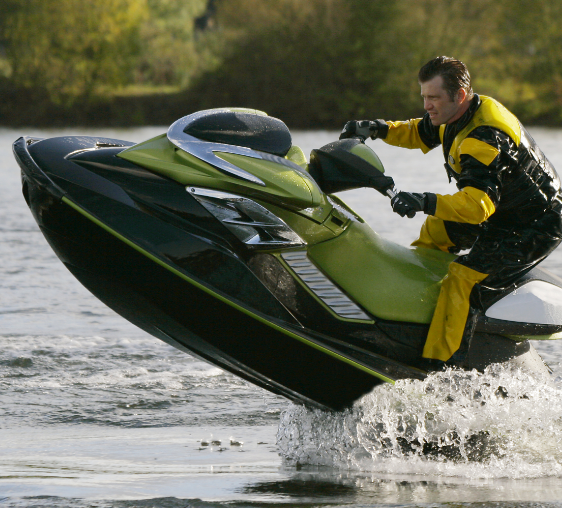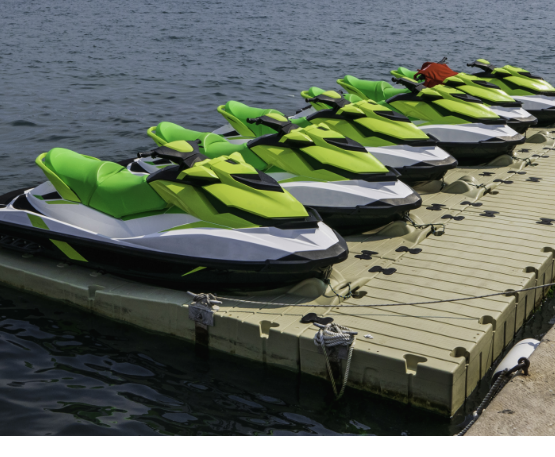How to Maintain your Personal Watercraft: Tips for Keeping your PWC in Top Condition
Whether summer is here or the sun’s just shining extra nice today, it’s time to hit the waves on your personal watercraft (PWC). Maybe you own a Jet Ski, WaveRunner, or SeaDoo, but no matter the brand, there’s no denying that one of the joys of summer is the thrill of riding the waves.
However, along with the fun comes the responsibility of maintaining your PWC. Neglecting its upkeep could lead to a decrease in performance and, ultimately, a shorter lifespan. That’s why we’ve compiled a list of 10 essential tips for PWC maintenance to ensure your craft stays fast and functional all season long.
When discussing personal watercraft maintenance, it’s crucial to emphasize the importance of jet ski maintenance, particularly for those who own jet skis. Regular maintenance of jet skis is paramount to avoid any unforeseen breakdowns or performance issues. One of the critical aspects of jet ski maintenance is ensuring the motor oil is changed regularly. Fresh motor oil is vital for the optimal functioning of the engine and to prevent any internal damage.
Additionally, attention must be paid to the air intake and cooling systems, as these are essential for the engine to operate efficiently and avoid overheating. It’s also crucial to remove excess water from the jet ski to prevent corrosion and other potential damages. Moreover, proper disposal of used motor oil is essential to avoid ground contamination. Following a meticulous oil change and maintenance routine will not only prolong the life of your jet ski but also contribute to environmental conservation by preventing pollution.
Whether you’re a new owner or a seasoned rider, these tips will help you keep your PWC in tip-top shape.
10 Essential Tips for Proper Regular Maintenance of Your PWC
As we mentioned, there is more to personal watercraft maintenance than just filling up the tank and hosing it down. Any boat owner must maintain a complete, proper maintenance regime to ensure its longevity and optimal performance. Plus, you want to make the most of your time out on the water.
Before we start on the top tips, there’s one that applies to all major machines, vehicles, and appliances; read the owner’s manual! They come with these and more basic maintenance recommendations, and better yet, they come with instructions for that specific model. They’re valuable insights ranging from schedules to even oil and cleaning tools to use.
So let’s finally get to those ten essential tips for keeping your PWC in top condition:
1. Make a Pre-Ride Check Every Time
Always protect yourself and your craft. Don’t go out there before conducting a thorough inspection of your PWC. Look for any visible hull damage, loose fittings, or leaks, and ensure that every safety feature is in top shape and working order. This includes the kill switch and the emergency shut-off. It goes without saying, but maybe worth repeating, that you should check your engine oil level as well as the condition of the fuel tank as part of your regular inspection before riding.

2. Wash Your PWC
Washing a Jet Ski or any personal watercraft isn’t just about having it look like new every time. You might not think it matters because it’s constantly in the water, but these are complex, mechanical vehicles, and the salt water can do a lot of harm if it’s not constantly washed away. Even freshwater and debris from rivers or lakes can build up, cause corrosion, and harm your craft without cleaning it.
First, be sure to use the right products and techniques. Avoid harsh chemicals and abrasive materials that can scratch or damage the surface of your hull.
After using it and before storing, remove any sears and seat covers you can clean, and then open the hood, storage area, or glove box to further wash away dirt, debris, or saltwater. Open any bung plugs or drain plugs and let the water drain from any compartment. With a hose, spray down everything that isn’t exposed to the electric and cooling system or gets into the fuel breather and coils.
Check the fuel tank and engine compartment to clean and wash away any blockage or grime that might harm the motor. Spend time cleaning accessories, seats, the pump area, and other nooks and crannies.
3. Flush the Cooling System
After the washing comes the flushing. They’re not the same thing! Flushing the cooling system with fresh, clean water is one of the most important aspects of regular maintenance for personal watercraft.
This process helps to remove any salt, sand, or debris that may have accumulated in the cooling system during use. Over time, these materials can cause corrosion and damage to the engine, which can lead to costly repairs.
One caveat here is that you should first consult your owner’s manual to see how any specific model is flushed. While most are done in the way we will explain here, different models and brands need different amounts of flushing times and agents.
Generally, to flush the cooling system, start by attaching a garden hose to the hose connector or fitting it on the watercraft’s intake grate. Start the engine and then turn on the water, allowing it to run for several minutes to circulate the clean water through the cooling system. Be sure to monitor the water pressure gauge to ensure the water is flowing properly. Once the engine has run for a few minutes, turn off the fresh water and allow the engine to continue running for a minute or two to clear out any remaining water.
Repeat this process several times throughout the season to keep the cooling system in good working order. It’s also important to use a high-quality flushing agent to help remove any buildup that may be present in the system. By taking the time to properly flush the cooling system, you can help prevent corrosion, remove any salt, sand, or debris, extending the life of your personal watercraft, and ensure that the engine continues to run smoothly for years to come.
4. Proper Fuel Management
Proper fuel management ensures that your personal watercraft runs smoothly and increases their lifespans.
Always use the recommended fuel for your PWC’s owner’s manual. Most PWC manufacturers recommend using 87-octane; it is essential to stick to this recommendation. Using the wrong one can damage your PWC engine and lead to costly repairs. Some older two-stroke engine models required pre-mixed fuel, which included oil, but newer four-stroke engine models don’t ask for pre-mixing. They now have two separate systems for oil and fuel.
And while this might be strange for first-time PWC owners, you must keep your fuel tank full when storing it in the off-season before using it again. Topping off the tank will prevent moisture from accumulating in it and causing corrosion. It also helps to prevent the formation of harmful deposits in the fuel system.
Loans And Financing That Fit Your Budget
If you plan to store your PWC for an extended period, it is essential to use a fuel stabilizer. Fuel stabilizers prevent fuel from breaking down and forming harmful deposits in the fuel system, which can cause engine damage. Following the manufacturer’s instructions when using a fuel stabilizer is important.
When taking it back out on the water, dump the old fuel, check the fuel tank, and fuel hoses, for any damage, and clean beneath and above it before filling up with fresh fuel. Be careful where you dump the old fuel! Check your local regulations before getting rid of your old gas.
Two-Stroke Engine Considerations:
As mentioned above, one of the most important considerations for two-stroke engine PWCs is maintaining the correct oil-to-fuel ratio in the same tank, typically 50:1. Using the wrong oil or fuel mixture can cause the engine to overheat and ultimately fail. Using high-quality oil and fuel is also important to prevent engine damage and reduce emissions.
Another important consideration is regular cleaning and maintenance of the engine, including the fuel system and spark plugs. Two-stroke engines are prone to carbon buildup, which can cause performance issues and reduce fuel efficiency. Regular cleaning and replacing spark plugs can also improve engine performance and reduce the risk of engine failure.
5. Lubrication and Greasing
Regularly lubricate moving parts and greasing points as recommended by the manufacturer, especially during the summer or whenever you plan on using them most. Pay attention to areas such as the steering system, joints, fittings, throttle cables, and pump components.
6. Battery Care
Another key tip is to pay close attention to your PWC’s battery. Keep it charged and replace it when necessary to avoid any unexpected issues on the water. When preparing to store your vehicle, disconnect the battery and store it apart. Also, keep the terminals clean to avoid corrosion and always follow the manufacturer’s recommendations for battery maintenance. Remember that most batteries have a life span of five years if used regularly. If you don’t use your PWC every year, don’t let your battery corrode and run out of charge. Don’t get left with a dead battery the next time you take your Jet Ski out to the water.

7. Proper Storage
Time takes its toll on any vehicle, even when storing it. First, prepare the PWC by washing it, flushing, inspecting the fuel lines and tank, disconnecting the battery, and filling the fuel tank, as we discussed earlier. After you get everything ready, store the PWC in a dry, covered area, preferably indoors. If outdoor storage is necessary, use a fitted cover designed for PWCs to protect it from the elements. Use a trailer to transport it when necessary.
When deciding to leave your PWC on the water for an extended period, we recommend using a PWC lift to avoid it having direct contact with fresh or salt water. This prevents hull delamination and fouling of the intake.
8. Trailer Maintenance
If you transport your PWC on a trailer, regularly inspect the trailer’s tires, bearings, lights, and suspension system. Ensure that the trailer is properly secured and aligned for safe towing.
9. Periodic and Annual Maintenance
Adhere to the recommended maintenance schedule outlined in the owner’s manual, just like you would service a car. This typically includes tasks such as oil changes, oil filter and air filter replacements, spark plug inspections, and impeller checks. Consider scheduling a seasonal maintenance or annual service with an authorized dealer or a qualified technician.
10. Safe Operating Practices
Always follow safe operating practices both in the owner’s manual and by local regulations and law enforcement, such as not operating the PWC in shallow water, avoiding excessive speeds in congested areas, and respecting no-wake zones. Being mindful of these practices will help prevent damage to the PWC and ensure the safety of yourself and others. Plus, you’ll likely avoid more wear and tear or accidents that will shorten your Wave Runner or Jet Ski’s lifespan.
Keep Your PWC in Top Condition and Don't Let Your Investment Go to Waste
You’re here to have fun and an exhilarating experience with your personal watercraft, so you probably want it to last as long as possible. But that takes investing time and effort into maintenance, so follow these essential tips and keep your PWC in top shape. Follow the manual, make regular inspections, always check your fluid levels, properly manage fuel, lubricate, take care of that battery, and keep it safe and covered.
And if you don’t have a PWC yet, contact Southeast Financial to get started on the road (or current) to adventure!

